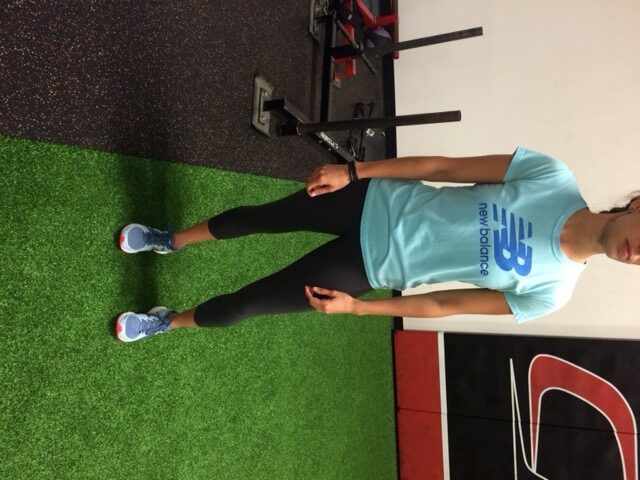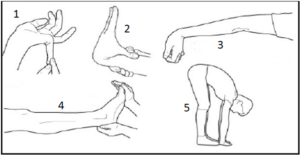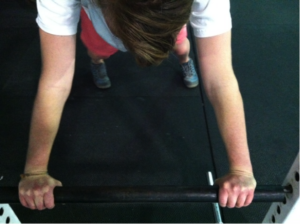
4 Ways Hypermobile Clients Can Improve Their Training
Today’s guest post comes from Cressey Sports Performance coach, Laura Canteri.
From super tight to super loose, people can fall at any point on the laxity continuum. Most women fall under the more hypermobile side of things, but there are a surprising amount of women who are nonetheless unaware of their extreme laxity. As a hypermobile female who learned the hard way, I want to share my knowledge and experiences with you to help improve your training and long-term health in four simple steps. While I’ll focus my attention on females in particular, the overwhelming majority of these lessons hold true for hypermobile males as well.
1. Create Self Awareness.
What is Hypermobility?
Each joint has a certain amount of laxity and can be either congenital (you were born with it; thanks, Mom and Dad) or as a consequence of repetitive activities (e.g., swimming). It shouldn’t be confused with instability, which would result from an injury that leads to excessive, uncontrolled range-of-motion. With that said, hypermobility is excessive laxity at a joint. If you often feel “tight” and don’t think that this article pertains to you, I encourage you to keep reading.
How Do I Know If I’m Hypermobile?
At Cressey Sports Performance, we like to use the Beighton scale to assess joint laxity and hypermobility. The screen is scored out of nine points in which there are five tests (see below). Unilateral tests should be scored on both sides with each positive test counting as one point. The higher the score, the higher the laxity.
1. Extend the pinky to >90° angle with the rest of the hand (left and right sides)
2. Flex the thumb to contact with the forearm (left and right sides)
3. Elbow hyperextension > 10° (left and right sides)
4. Knee hyperextension > 10° (left and right sides)
5. Toe touch with knees straight, touch the palms flat on the floor

2. Remove Static Stretching From Your Routine.
From youth to college basketball, I had my fair share of injuries – from sprained ankles to dislocated shoulders -but despite having such loose joints, I would always feel “tight.” I couldn’t touch my toes, clasp my hands behind my back, or do any “cool” tricks. So, I incorporated static stretching before and after every game/practice to decrease my risk for injuries. Good news: I was eventually able to touch my toes and clasp my hands behind my back. Bad news: I continued to have even more shoulder instability issues, which resulted in surgery.
So, what gives? I wouldn’t feel “tight” if I was hypermobile, right? Wrong. Let me explain. When other structures aren’t working properly (i.e. your ligaments and tendons) to support a joint, the surrounding muscles work overtime to stabilize and protect it. This mechanism is known as “protective tension” and is the reason why someone who is hypermobile may feel “tight.” Our body creates trigger points as a strategy to create stability where we don’t have it. It may feel good to stretch in the moment, but stretching muscles around an already lax joint capsule will only lead to more instability and greater risk for injury. It’s like picking a scab; you feel better in the short-term, but wind up with longer term problems.
Long story short, if you’re looking for a quick reduction in tightness, get rid of the static stretching and grab yourself a foam roller instead – and then follow that work up with some good stability exercises.
3. Stay Away From End Ranges.
Women who have a lot of joint laxity tend to stand, sit, and train in extreme end ranges (see pictures below). When joints are constantly loaded beyond normal range, the ligaments will continue to become more lax and the joint will experience more wear and tear overtime. Here are a few examples:
Hyperextended Elbows During a Push-up

Hyperflexed Lumbar Spine and Hyperextended Cervical Spine During Sitting
Hyperextended Knees During Standing
Hyperextended Knees and Right Hip Shift During Standing
Whether you are sitting behind a desk at work, attending a yoga class, or lifting weight, it is important to be aware of your body position and stop just short of end range.
4. Improve Motor Control.
Generally speaking, women have greater Q-angles (measured from hip to patella along femur) and a higher predisposition to joint laxity compared to men. Looser joints require more stability and motor control; therefore, learning better movement patterns is critical for improving long-term health and joint integrity.
For example, if you are experiencing discomfort in the front of your shoulder, one exercise you could incorporate is the standing external rotation. This is a great exercise for hypermobile individuals to increase posterior rotator cuff strength, increase shoulder stability, and improve motor control by learning how to keep the ball centered in the socket.
Regardless of what exercise you perform, in order to improve motor control you must:
a. Be present: Eliminate distractions (e.g. texting, Facebook, etc.). If you are not focused, you will naturally fall back to your compensatory movement patterns
b. Maintain a neutral spine: It is common for hypermobile women to overextend their lower back and rely on bony stability; therefore, learning how to execute and maintain a neutral spine is important in every exercise in order to set a foundation for better alignment
c. Slow down: Perform each rep in a controlled manner, and emphasize quality over quantity.
d. Train in non-fatigued state: Be aware of how you feel, as fatigue will negatively affect your ability to learn new movement patterns
Conclusion
My personal experiences have led me to believe that hypermobility, especially for women, is more common than one might think. Creating awareness for yourself or your clients is the first step in the right direction. As Eric always says, “Assess, don’t guess.”
Happy training to all my hypermobile readers out there!
About the Author
Laura Canteri (@LC_Canteri) heads up strength camps (group training) at Cressey Sports Performance – Florida. She completed her master’s degree in exercise physiology at Florida Atlantic University, and also is Precision Nutrition certified. In addition to her work at CSP, Laura works with folks from all walks of life through her distance-based consulting. You can reach her at l.c.canteri@gmail.com.





